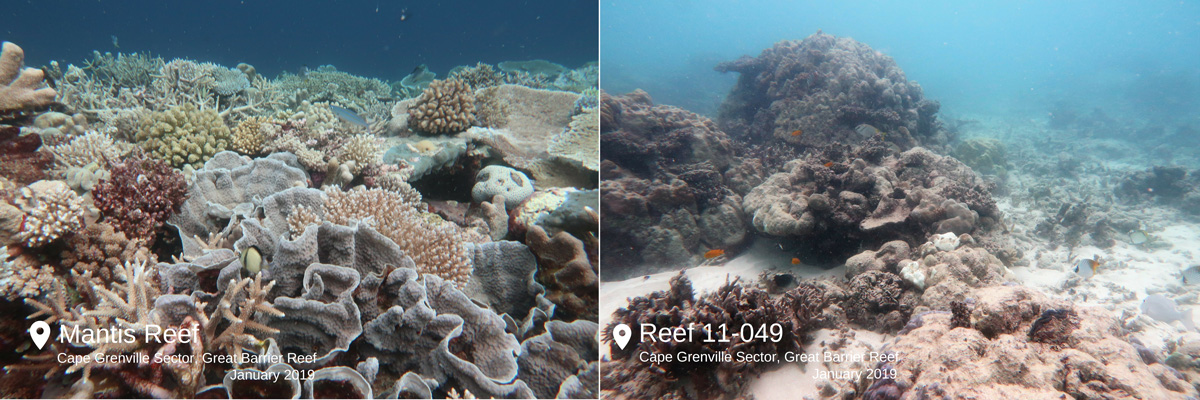
Global S&T Development Trend Analysis Platform of Resources and Environment
| Early data shows mixed bill of health for the far northern Great Barrier Reef | |
| admin | |
| 2019-03-01 | |
| 发布年 | 2019 |
| 语种 | 英语 |
| 国家 | 澳大利亚 |
| 领域 | 资源环境 |
| 正文(英文) |
Reef condition for the far northern Great Barrier Reef is variable, according to early data released by the Australian Institute of Marine Science. Seventeen reefs were surveyed from the RV Solander during an expedition to the remote Cape York region in January. The information gathered, is crucial to support greater understanding of the Great Barrier Reef ecosystem, essential for its long-term management. AIMS marine ecologist Dr Mike Emslie said some reefs they visited in the far north had not yet recovered from severe bleaching in the area during the summers of 2016 and 2017, while others were in good condition. “Some reefs that were severely bleached in 2016 are still in bad shape,” Dr Emslie said. “However, other reefs that escaped the worst of the bleaching still have reasonably healthy amounts of coral.” The Australian Institute of Marine Science has a commitment to monitor 132 reefs from the north to the south of the Great Barrier Reef every two years, but extra funding allowed additional research to be undertaken during this expedition.
Dr Emslie said the funding from the Australian Government Reef Trust Partnership and the Great Barrier Reef Foundation had allowed the team to expand on its regular two-yearly surveys of live coral cover in the remote region. For the first time, detailed information was collected from the region by AIMS’ Long Term Monitoring Team. “The Cape York area in the far north of the Great Barrier Reef is incredibly remote and is a difficult, expensive region to monitor. Historically our monitoring in this area has been limited to broad-scale surveys of live coral cover and crown-of-thorns-starfish,” Dr Emslie said. The additional funding enabled scientists to collect detailed information on 3-dimensional reef structure, numbers and health of juvenile corals and coral community composition, numbers and diversity of both fish and reef sharks, and other more detailed coral health data. Dr Emslie said the remote location meant more time was required at sea and extensive work had been required to undertake the extra components of the monitoring research. “We were able to put more people in the field and collect much more detailed information on this region, providing vital context for reef health and a baseline for future monitoring,” he said. “This expedition on our biggest research vessel the RV Solander, allowed more time and more people to measure the finer details of reef health that help scientists and managers better understand how the region is faring after the severe bleaching,” Dr Emslie said. He said early results from these additional surveys showed there were young corals, little incidence of coral disease, few coral-eating crown-of-thorns starfish, and good fish and shark populations. “This all indicates that for these reefs there is good prospects for their health to improve, as long as they are not affected by major disturbances.” However, he said the team also recorded low levels of bleaching on some reefs as well as broken corals, which appeared to be evidence of recent storm damage from Tropical Cyclone Penny. These impacts would have gone unrecorded had the team not been surveying at the time. “It was clear the reefs in the region are still being impacted by previous disturbances,” Dr Emslie said. “The Great Barrier Reef is resilient, but our long-term data shows reefs need decades without disturbance to fully recover.” Further results of reef and fish health surveys, as well as comparisons of monitoring techniques, and investigation into the heat tolerance of corals will be available at a later date. To find out more, read the Princess Charlotte Bay and Cape Grenville sector long-term monitoring report on the AIMS website. The AIMS Long-Term Monitoring Program has monitored the condition of reefs on the Great Barrier Reef since 1983. It is the most comprehensive record of reef health available for the Great Barrier Reef. This expedition was funded by the partnership between the Australian Government’s Reef Trust, the Great Barrier Reef Foundation and AIMS. |
| URL | 查看原文 |
| 来源平台 | Australian Institute of Marine Science |
| 文献类型 | 新闻 |
| 条目标识符 | http://119.78.100.173/C666/handle/2XK7JSWQ/233010 |
| 专题 | 资源环境科学 |
| 推荐引用方式 GB/T 7714 | admin. Early data shows mixed bill of health for the far northern Great Barrier Reef. 2019. |
| 条目包含的文件 | 条目无相关文件。 | |||||
| 个性服务 |
| 推荐该条目 |
| 保存到收藏夹 |
| 查看访问统计 |
| 导出为Endnote文件 |
| 谷歌学术 |
| 谷歌学术中相似的文章 |
| [admin]的文章 |
| 百度学术 |
| 百度学术中相似的文章 |
| [admin]的文章 |
| 必应学术 |
| 必应学术中相似的文章 |
| [admin]的文章 |
| 相关权益政策 |
| 暂无数据 |
| 收藏/分享 |
除非特别说明,本系统中所有内容都受版权保护,并保留所有权利。
修改评论